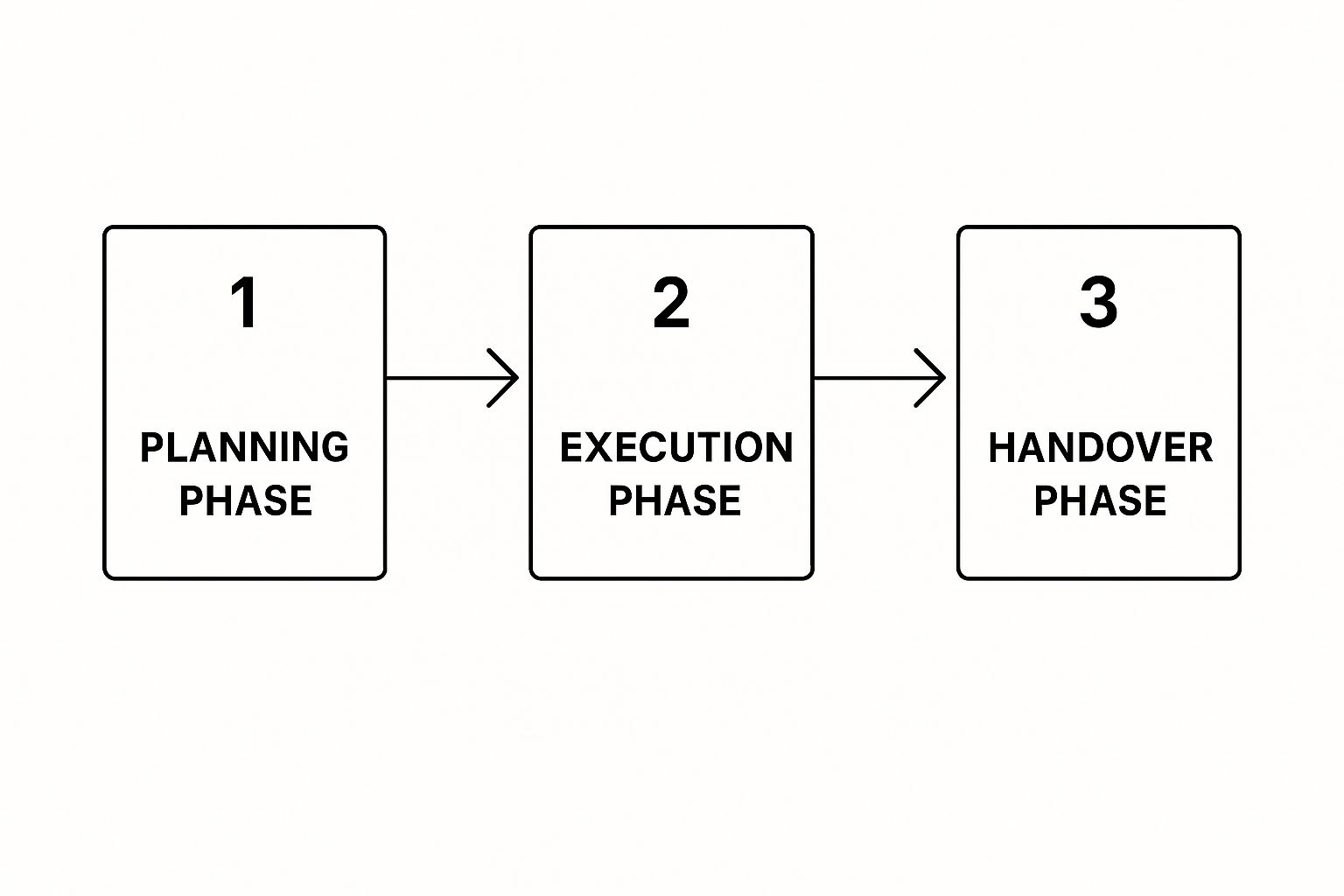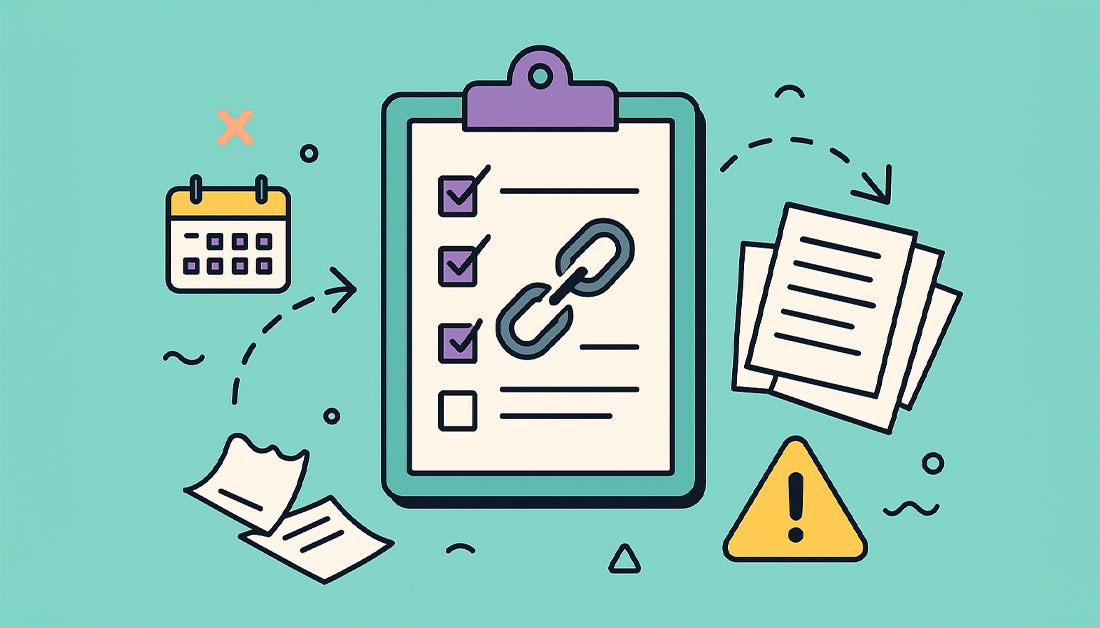Why Most Transition Plans Fail (And How To Fix Yours)

Let’s be real, employee transitions can be a headache. It’s not always a lack of notice, either. I’ve seen companies in a frenzy even with months to prepare. The core issue? They treat every departure the same, regardless of whether it’s a planned retirement or a surprise resignation.
This one-size-fits-all approach just doesn’t work. It overlooks the specifics of each situation, leading to major knowledge gaps and workflow disruptions. Think lost client contacts because nobody knew who inherited them, or stalled projects because crucial tribal knowledge walked out the door. These hidden costs add up.
Prioritizing Knowledge Transfer
One common trap is focusing only on the replacement person, not the knowledge they held. A solid employee transition plan template tackles this head-on by prioritizing knowledge transfer. This isn’t just about documenting processes. It’s also about capturing those undocumented insights and relationships that truly drive success.
For example, picture a sales team lead leaving. Finding someone with similar experience is a good start. But what about the personal connections they’d nurtured with key clients? Those relationships are valuable and take time, and losing them can directly hit the bottom line.
The Frequency of Transitions
Think about how often people change jobs. On average, it’s 12 times during a career in the U.S. Add in global workforce shifts, and McKinsey predicts 14% of us will be in different roles by 2030. This underscores the absolute necessity of flexible and robust transition strategies. You can dive deeper into these job transition trends here: https://www.octanner.com/en-gb/global-culture-report/2025-job-transitions.
Failing to document key processes and workflows leaves organizations exposed. It creates reactive scrambling when someone leaves, not a proactive, smooth handoff.
The Need for a Clear Process
Many organizations simply lack a defined process. They rely on improvised handovers and hope for the best. This inconsistency creates chaos. A standardized employee transition plan template ensures everyone is on the same page, reducing stress and safeguarding crucial information.
It’s like having a reliable recipe. Even with different ingredients (employees), the outcome is consistently good. By addressing these common pitfalls, you can turn employee departures from potential disasters into genuine opportunities for growth and improvement.
Navigating Every Type Of Employee Transition
The biggest mistake with employee transitions? Treating every single one the same. A retirement needs a totally different approach than a sudden resignation. Same goes for an internal promotion versus a new external hire. Many companies just use one rigid process, though. And trust me, that causes headaches.
Understanding The Nuances of Transition
Let’s talk internal promotions. They’re exciting, right? But they can be surprisingly complicated. You’re changing team dynamics, maybe leaving a knowledge gap in the old role, and you’ve got to onboard a replacement, fast. A generic employee transition plan template just won’t cut it.
Another tricky one? Temporary gigs that become permanent. These often lack a formal handover, so capturing that temporary knowledge is crucial. Your transition plan needs to be adaptable. Think of it like packing for a trip – a weekend camping trip needs different gear than a month in Europe.
Addressing Different Departure Scenarios
What about when someone leaves involuntarily? Layoffs or performance-based exits need careful handling, particularly with communication. No celebratory send-offs here. It’s all about clear, respectful communication with everyone involved.
Think about the job market right now. The World Economic Forum predicts huge changes. They estimate 14% job growth and 8% job displacement due to structural shifts. This makes solid transition processes even more critical.
Flexible Planning For Consistent Success
Every transition has unique communication needs, too. Announcing a promotion has a different tone than someone resigning. A flexible employee transition plan template accounts for those nuances. It’s thorough, but not rigid. That adaptability means you’re ready for anything, minimizing disruption, no matter the circumstances.
Crafting Your Employee Transition Plan Template
Let’s skip the theory and dive into building a real-world employee transition plan template – one that actually works. We’ll tap into the wisdom of seasoned HR pros who’ve honed their processes through years of experience. This means creating a template that even the busiest managers will actually use (and use correctly).
This infographic shows the key phases of a solid employee transition plan: Planning, Execution, and Handover.

A successful transition, as you can see, is built on careful planning, followed by diligent execution, and capped off with a structured handover. Each phase depends on the last, so a joined-up approach is key. If you’re interested in more on work transition plans, check out this post: Work Transition Plan Template.
Essential Elements of Your Template
Building a practical template is a balancing act. You need enough detail to guide the process without making it too complex. No one wants to wade through unnecessary paperwork.
- Immediate Needs: Zero in on the must-have information right now. Think key responsibilities, current projects, and vital contacts. Like a first responder, you want to address the most critical elements first.
- Realistic Timelines: Let’s be honest, things rarely go exactly as planned. Build in some buffer time for unexpected hiccups. Transitions are especially prone to the unexpected.
- Stakeholder Involvement: Be crystal clear about who needs to be involved at each stage. This could include HR, IT, the departing employee’s manager, and their team.
To illustrate the key components of an effective template, I’ve put together a handy table:
Essential Employee Transition Plan Template Components
A comprehensive breakdown of must-have sections in your transition plan template with their specific purposes and recommended timelines
| Template Section | Purpose | Timeline | Key Stakeholders |
|---|---|---|---|
| Key Responsibilities | Documents the core duties and tasks of the role. | Immediately upon notice | Departing Employee, Manager |
| Current Projects | Lists all active projects and their current status. | Immediately upon notice | Departing Employee, Manager, Project Team |
| Essential Contacts | Compiles a list of key internal and external contacts. | Within the first week | Departing Employee, Manager |
| Handover Procedures | Outlines the specific steps for handing off responsibilities. | Two weeks before departure | Departing Employee, Manager, Receiving Employee |
| Knowledge Transfer | Details how crucial knowledge will be shared. | Ongoing throughout the transition | Departing Employee, Manager, Receiving Employee |
| IT Access and Systems | Specifies procedures for revoking or transferring system access. | One week before departure | Departing Employee, IT |
This table provides a solid framework for your template, ensuring you capture the most important information. Remember, it’s a starting point – you can customize it further based on your specific needs.
Beyond the Basics
Savvy HR professionals go beyond the obvious. They focus on capturing undocumented processes – that “tribal knowledge” that lives in people’s heads. These are the unwritten rules and informal procedures that often slip through the cracks. Documenting them can be the difference between a smooth transition and utter chaos.
For instance, a departing marketing manager might not have their informal mentorship of junior team members listed in their official responsibilities. Losing that mentorship can have a huge impact on the team’s performance.
Building a User-Friendly Template
Your template should guide people, not overwhelm them. Break the transition down into digestible chunks. Steer clear of lengthy forms and complex procedures.
Think about using checklists or prompts. This helps people feel like they’re making progress and keeps those crucial details from getting lost. The goal is to make the entire process as simple and efficient as possible for everyone involved. A well-designed template in Jira Cloud combined with the Out of Office Assistant can really streamline this.
Mastering Knowledge Transfer That Actually Sticks

Here’s the thing about employee transition plans: they often fall flat when it comes to knowledge transfer. It’s frequently a last-minute fire drill instead of a well-considered process. I’ve chatted with folks who’ve aced complex handovers, and they all stress the same thing: capturing everything – the official documentation and the unwritten, insider knowledge.
Going Beyond Basic Documentation
Most knowledge transfer focuses on written procedures. But what about the critical info that’s locked away in someone’s brain? Think about those unspoken best practices, the client relationships built on years of trust, or the subtle understanding of internal dynamics. That kind of stuff rarely makes it into an employee handbook.
When building your employee transition plan template, pre-built online templates can be a great foundation. They give you a solid structure for organizing the knowledge transfer process.
For instance, picture a software engineer leaving. Yes, their code is (hopefully) documented. But what about their intimate knowledge of that one system’s quirks, or their connections with product managers in other teams? That kind of insight is invaluable, and transitions often lose it.
Practical Techniques for Effective Transfer
So, how do you capture this hidden knowledge? One way is the good old “brain dump.” Set aside dedicated time for the departing employee to share everything they can think of, even if it seems minor. Record these sessions for later review and build a searchable info hub.
Reverse mentoring is another powerful technique. Have the departing employee mentor their replacement on the less tangible aspects of the role. This flips the script on traditional mentoring and can be surprisingly effective.
For more ideas on knowledge sharing, check out this article on How To Cross-Train Employees.
Transferring Relationships and Institutional Memory
Knowledge transfer isn’t just about tasks and processes. It’s also about relationships and company history. Who are the essential contacts inside and outside the organization? What are the unwritten rules when working with different teams?
Encourage departing employees to actively introduce their replacements to key people. This helps forge those crucial relationships and ensures a smooth handover of projects. Documenting these connections in your employee transition plan template is key.
This proactive approach to knowledge transfer is what sets thriving organizations apart during transitions. It ensures vital information doesn’t disappear when someone leaves. It builds resilience and preserves institutional memory, making the entire organization stronger.
Managing Stakeholder Communication Without The Drama
Poor communication during transitions can cause a real mess. Think confused teams, frustrated clients, and even damage to your company’s reputation. So let’s talk about how to keep everyone in the loop effectively, without adding unnecessary stress or burying them in information.
Tailoring Communication to Different Stakeholders
One size doesn’t fit all when it comes to transition communication. Different stakeholders need different info at different times. Your legal team, for instance, has completely different needs than your clients, and what you tell an executive is not what you tell the departing employee’s team. Understanding these nuances is crucial.
Let’s say a senior engineer resigns. Their team needs to know how their projects will be affected immediately. Clients, however, need assurance that their projects are still in good hands and will continue without a hitch. Effective knowledge transfer, often facilitated by solid knowledge management tools, can really help prevent these communication breakdowns.
Balancing Transparency and Discretion
Transparency is important, but too much can be a bad thing. There’s a delicate balance between keeping people informed and feeding the rumor mill. Finding that sweet spot, especially in sensitive situations, is crucial.
Imagine a manager being let go due to performance issues. Internal teams need to understand the reason for the leadership change, but sharing specific details externally could create legal problems. A solid employee transition plan template needs to include clear guidelines for these tricky communications. You might find this helpful: Cross-Functional Team Communication.
Practical Templates for Common Communication Touchpoints
Pre-written templates are your secret weapon. They save a ton of time and ensure consistency. Create templates for common scenarios like resignation announcements, internal team updates, and client communications. Make sure these templates are flexible enough to be tailored to specific circumstances.
Employee dissatisfaction is a major factor in turnover. Did you know that 43% of employees thinking about quitting prioritize training and development? It’s a key part of what’s being called the “Great Re-Resignation.” Learning about employee retention trends and addressing these concerns proactively through open communication can help you keep your valuable people.
Handling Tricky Situations
Not all transitions are smooth sailing. What happens when someone leaves on bad terms, or when confidentiality is absolutely essential? You need a plan for these more challenging situations.
Consider a very public departure. Your communication strategy needs to handle potential media inquiries and protect your company’s reputation. A well-designed employee transition plan template anticipates these complications and offers guidance on navigating them effectively. This minimizes disruption and maintains stability during uncertain times.
Rolling Out Your Transition Plan Successfully

Creating a solid employee transition plan template is a great first step, but it’s just the beginning. Think of it like buying a shiny new toolbox – it won’t do much good sitting unopened in the garage. The real magic happens when the entire team uses it consistently and correctly. This means getting everyone on board, including those managers who might be a little hesitant about new processes.
Winning Over Reluctant Managers
Let’s be honest, some managers might view a new template as just another administrative burden. The trick is to show them how it actually simplifies their lives and prevents future problems. Highlight the advantages they care about, like minimizing disruptions, speeding up onboarding, and keeping projects moving forward.
For example, explain how a standardized process eliminates the frantic search for important documents when someone leaves. Show them how a clear handover process reduces the constant stream of questions from the new employee, making the transition smoother for everyone involved.
Ensuring Consistent Use
No one wants to become the “template enforcer,” constantly reminding people to fill out forms. The secret? Integrate the template into your existing workflows. Make it easily accessible and user-friendly.
Jira Cloud is a perfect example. A well-designed template within Jira, combined with the Out of Office Assistant, can automate much of the transition process. Automated reminders and notifications gently guide people along, eliminating the need for constant nagging. This also connects to effective absence management – something you can learn more about here: Check out our guide on absence management strategies.
Measuring Real Success
Simply completing the template isn’t enough. True success means tangible improvements. Think fewer project delays, faster onboarding for new hires, and happier clients. Tracking these metrics over time reveals the true impact of your transition plan.
For instance, track the average time it takes a new hire to become fully productive in their role. If your employee transition plan template is effective, this time should decrease significantly. This provides concrete evidence of the process’s value.
To help you track these important metrics, I’ve put together a handy table:
Introducing the “Transition Plan Success Metrics and Measurement Timeline” table, designed to help you track key performance indicators before, during, and after employee transitions. This table recommends specific measurement intervals to keep you on top of your progress.
| Metric | Measurement Timing | Target Range | Data Source |
|---|---|---|---|
| Time to Full Productivity (New Hires) | Before, During, After Transition | Decrease by 25% | Jira Reports, HR Onboarding System |
| Project Delays | Before, During, After Transition | Decrease by 15% | Jira Project Tracking |
| Client Satisfaction (Transitioned Projects) | After Transition | Increase by 10% | Client Surveys, Feedback Forms |
| Number of Unanswered Questions (New Hires) | During, After Transition | Decrease by 50% | Internal Communication Logs |
This table gives you a clear overview of what to measure and when, offering valuable insights into the effectiveness of your transition plan. By focusing on these metrics, you can demonstrate the positive impact of your efforts.
Continuous Improvement Through Feedback
No template is perfect right out of the box. Regularly solicit feedback from those using it. Ask what’s working, what’s not, and what could be improved. This feedback loop is crucial for continuous improvement.
Perhaps your template is too detailed for some roles or lacks crucial information for others. Gathering feedback across the organization allows you to refine the template and ensure it truly meets everyone’s needs. This iterative process ensures your employee transition plan template remains relevant and effective as your organization grows and changes, constantly refining the process for optimal results.
Your Roadmap To Transition Planning Excellence
So, we’ve talked about the common traps and the different flavors of transitions. Now, let’s get down to brass tacks. How do we actually do this? This isn’t some pie-in-the-sky theory; it’s a practical, boots-on-the-ground approach that works within the realities of your organization.
Prioritizing Your Action Plan
It’s like building a house. You wouldn’t start with the roof, would you? Foundation first. Same goes for your employee transition plan template. What are the absolute must-haves to prevent a meltdown when someone leaves?
Start with capturing crucial responsibilities and ongoing projects. These are the lifeblood of your team. Then, nail down key contacts and handover procedures. I’ve seen firsthand how much smoother things go when this is in place.
Setting Milestones and Tracking Progress
A plan without milestones is just a wish. Set specific, measurable checkpoints. This keeps you on track and gives you something to celebrate along the way. Launching a new transition plan can also involve onboarding. This remote onboarding process guide has some solid tips that can apply to transitions too.
For example, if you want to roll out the employee transition plan template across all departments in three months, break it down. Target one department per month. Use the feedback from the early adopters to tweak and improve the process. This phased approach feels less overwhelming and provides quick wins to keep everyone motivated. Another helpful resource might be this guide on Change Management Process Templates.
Resources for Continued Learning
Transition planning isn’t a set-it-and-forget-it kind of thing. It’s a constant learning process. Find resources that can help you along the way.
Consider joining professional groups or following industry blogs. Sharing tips and staying current on best practices is a game-changer. It’s like having a built-in support system for all your HR hurdles.
From Scramble to Strategy
The goal? Transform how your organization handles transitions. Ditch the last-minute scramble and build a smooth, strategic process. This not only minimizes disruption but also makes your organization stronger.
Want to boost your team’s productivity and peace of mind? Explore resolution Reichert Network Solutions GmbH and see how our Out of Office Assistant for Jira Cloud can automate handovers and keep your workflows humming, even when people are out.
